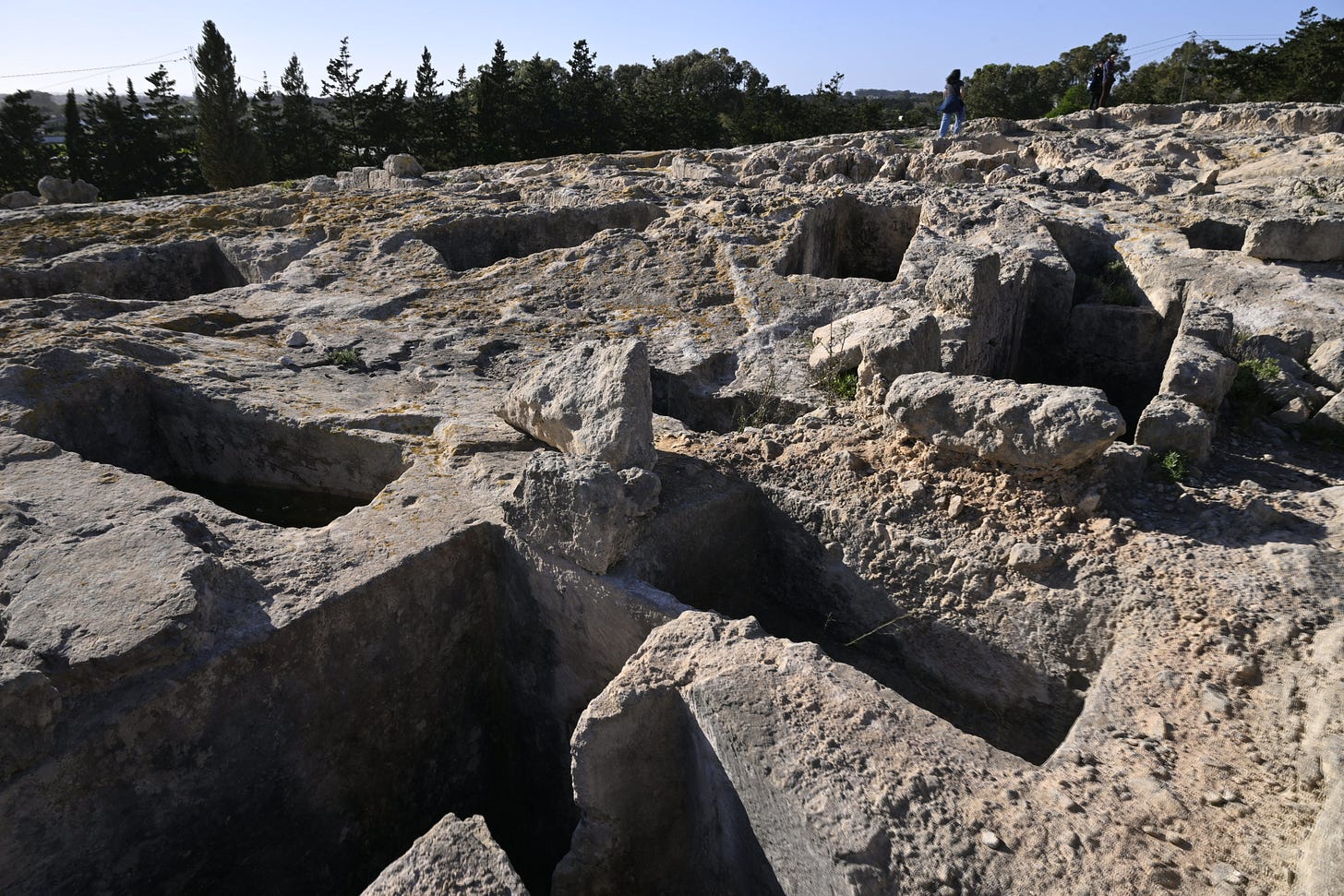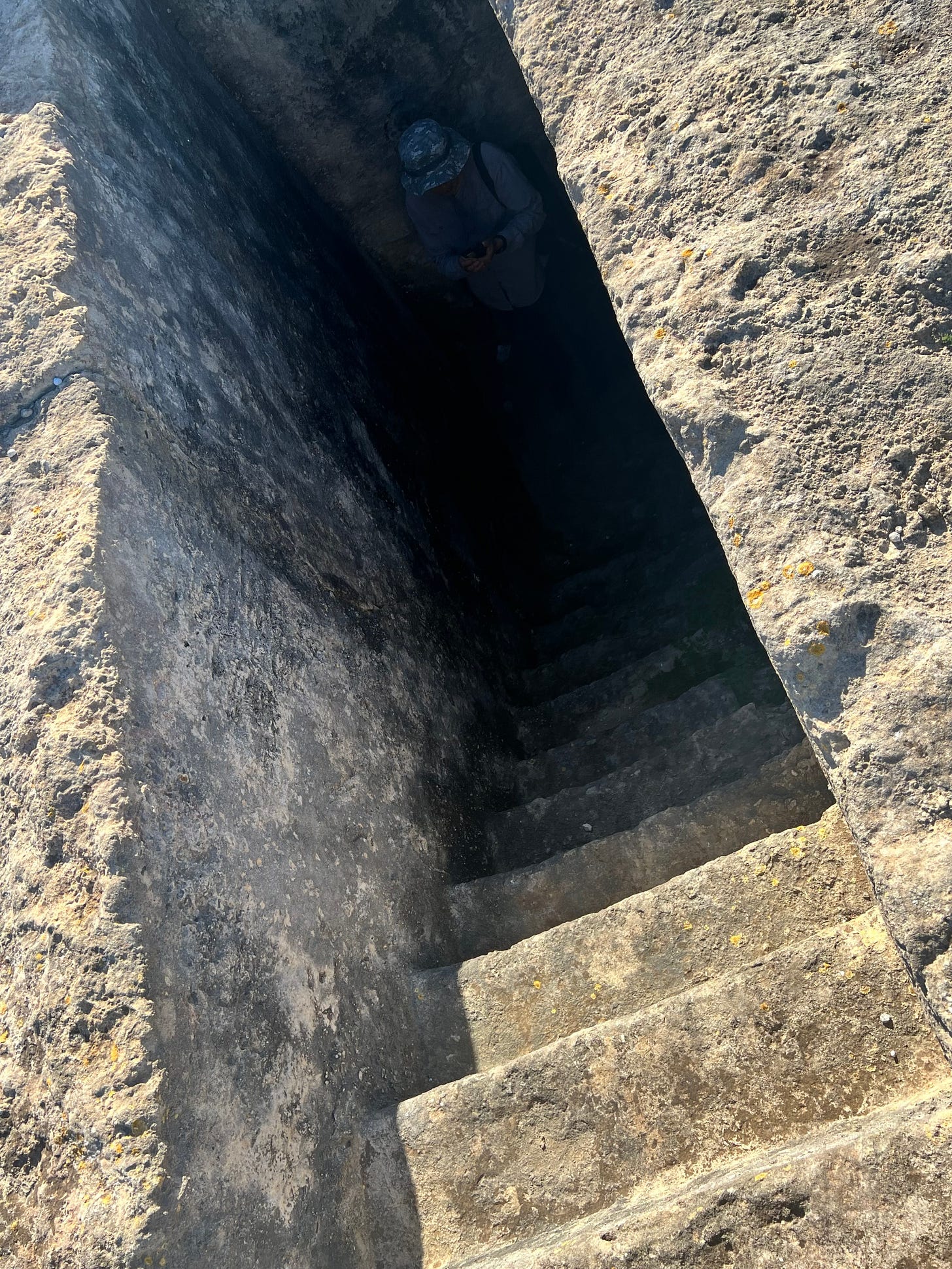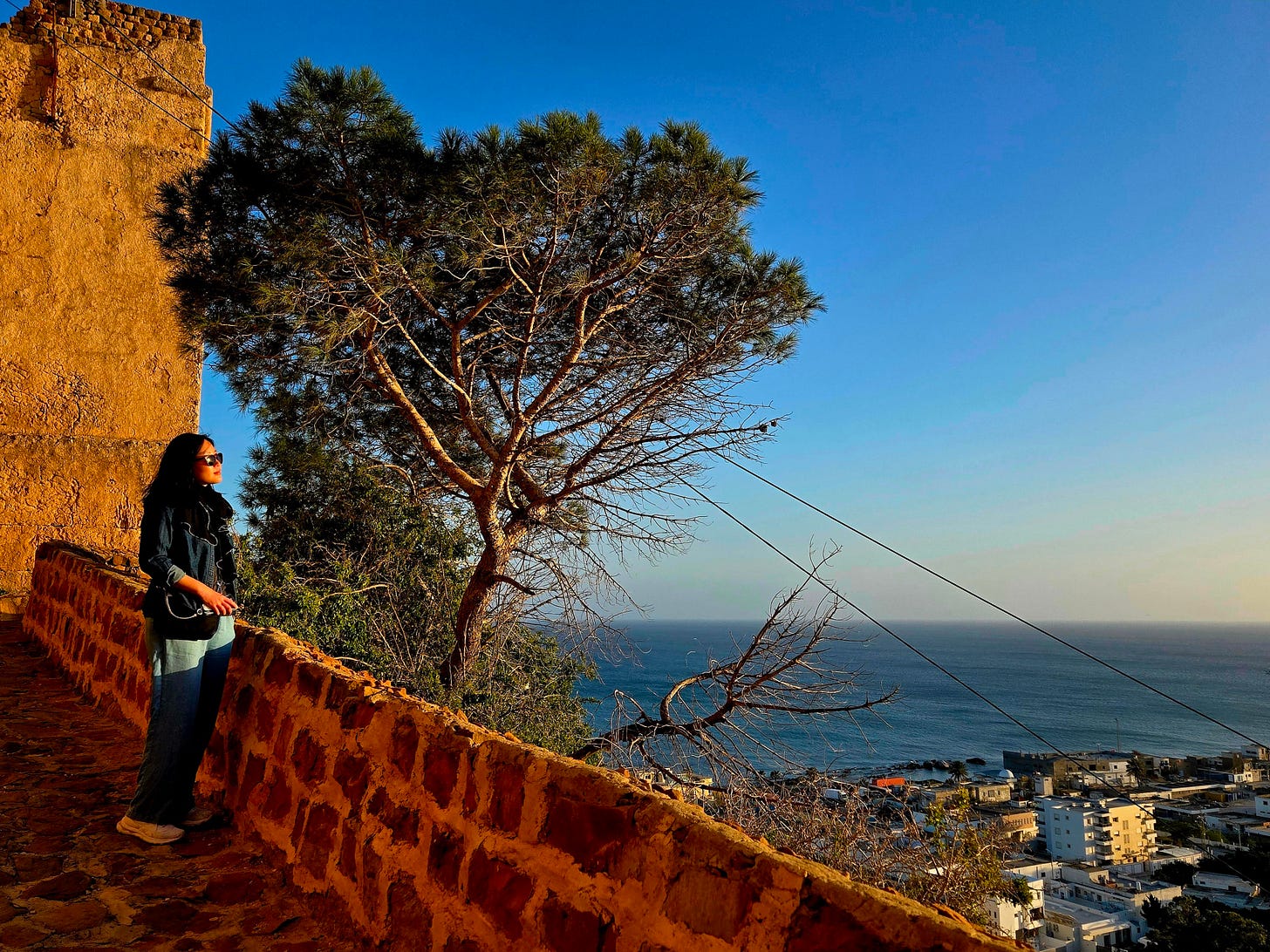The Necropolis Next Door: Adventuring Through Cap Bon's Forgotten Coastline
A day of archaeological extremes amid Tunisia's casual antiquity
If there's one thing I've learned about hotel breakfast buffets, it's that they're reliable cultural barometers. This particular morning at Iberostar Averroes offered a perfect case study: there we were, bundled in light jackets planning archaeological expeditions, while cruise passengers from Norway paraded poolside in swimwear that screamed "Mediterranean vacation!" despite temperatures that had locals reaching for wool scarves. I couldn't fault their logic—when you've escaped Nordic winter for North African "warmth," relativity becomes your best friend. Sixty degrees might not scream "swimming weather" to the average Tunisian, but to someone who left behind sub-zero temperatures and perpetual darkness, it's practically tropical.
After days of desert exploration where our rental car had aged roughly ten years traversing unpaved roads to abandoned ksour, we were ready for coastal adventures. Kerkouane—an ancient Punic settlement with the distinction of being destroyed before the Romans could get to it—beckoned from the northeastern coast. But first, the eternal traveler's dilemma: finding lunch somewhere between our late start in Hammamet and our archaeological destination.
Shortcut to Nowhere: In Search of Seafood and Finding Tombs
My pre-trip research (which at this point in our journey had proven to be approximately 60% accurate—a batting average I wouldn't brag about) had identified three seafood restaurants along the coast, all promising fresh catch and uninterrupted Mediterranean views. Their websites had conveniently neglected to mention whether they actually operated during February, when tourists were scarce and fishing boats often remained docked. Still, the promise of eating seafood within sight of its source seemed worth the gamble.
The man behind the wheel—whose previous "shortcuts" had delivered us to magnificent vistas and terrifying cliff edges in equal measure—spotted what appeared to be a more direct route on the map. Those of us familiar with his navigational philosophy exchanged glances containing entire dissertations on previous "direct routes" and their consequences, but said nothing. Hope, that most persistent of travel companions, suggested this time might be different.
It wasn't.
The innocent beginning—a paved secondary road with actual lane markings—dissolved with alarming speed into something that stretched the definition of "road" beyond recognition. What began as occasional potholes evolved into a continuous washboard of loose gravel, while the path narrowed with each kilometer as if gradually changing its mind about being traversable. Our rental car, already bearing the scars of desert expeditions, protested with mechanical sounds I'm fairly certain weren't covered in the insurance policy.
When faced with the option to turn back or continue, we made the distinctly human choice to preserve our dignity rather than our suspension system. "It has to improve eventually," became our mantra, repeated with diminishing conviction as we bounced over another section that appeared to have been last maintained during the Punic Wars.
When we finally emerged at the coast, the Mediterranean revealed itself in a gradient of blues so implausibly perfect they looked digitally enhanced. The water was crystal clear, revealing individual fish navigating between rocks and patches of seagrass. On the horizon lay the theoretical location of Malta, our next destination, though geography and the Earth's curvature conspired to keep it hidden from view.
What wasn't hidden was the complete absence of open restaurants. The seafood establishments I'd identified stood in states of seasonal hibernation—shuttered windows, stacked chairs, and terraces empty of everything except winter debris and the occasional opportunistic seagull. The Mediterranean sparkled with maddening perfection.
As hunger blurred our decision-making, something unexpected appeared on my map: a Punic necropolis tucked between residential buildings near the coast. After brief deliberation (consisting mostly of questioning whether ancient tombs counted as a lunch alternative), we navigated to coordinates that seemed improbably specific for an archaeological site so casually integrated into a modern neighborhood.
The necropolis appeared without ceremony—no interpretive center, no ticket booth, not even a proper sign. Just an open metal gate suggesting either admirably casual attitudes toward archaeological preservation or simply that nobody expected visitors. Sheep and goats, tethered to rocks with frayed ropes of varying lengths, regarded us with the particular disdain that only farm animals can perfect—a look suggesting they'd seen civilizations rise and fall and remained thoroughly unimpressed by both. One sheep, visibly injured and closest to the gate, alternated between frantic running and soft crying that somehow made the entire scene feel more unsettling.
"I'll wait here," my mother announced with the decisive tone of someone who has watched enough archaeological horror films to know better. My aunt, equally unconvinced about the recreational potential of ancient burial chambers, joined her in the sunshine while my uncle disappeared down the nearest staircase with the reflexive enthusiasm of someone who has never met an ancient site he didn't want to photograph.
I stood at the threshold, caught between curiosity and common sense. What confronted me was a vast archaeological landscape carved directly into the coastal bedrock—dozens upon dozens of burial chambers spread across the hillside, their entrances yawning open like dark mouths. The necropolis sprawled far beyond what my eyes could initially comprehend, with burial chambers arranged in layers suggesting different eras of construction, some obviously more ancient than others. Most alarming was the complete absence of safety features—no guardrails, no barriers, not even ropes to mark dangerous drops. One misstep could transform a curious tourist into an involuntary permanent resident.

The full scope of this necropolis slowly registered—this was part of ancient Kerkouane's burial grounds, with tombs scattered across the coastal hills of Cap Bon dating back to the 4th to 3rd centuries BCE when Punic civilization flourished in this region, before being abandoned during the First Punic War around 250 BCE. This wasn't some minor archaeological footnote but one of the most significant Punic funerary sites in North Africa.
The rain-slicked steps felt treacherous under my boots, requiring deliberate movement to avoid an ungraceful descent into what archaeologists might later classify as "that weird modern skeleton found in the Punic tomb." I ventured into one chamber near the entrance, where centuries of dust and stillness created an atmosphere thick enough to touch. The space featured precisely carved angles and smooth surfaces that spoke to sophisticated engineering rather than primitive construction.
Many of the burial chambers had filled with rainwater, creating eerie reflecting pools at their lowest levels. The necropolis wasn't just historically significant—it was cinematically perfect for a horror film, combining ancient burial practices with complete abandonment in a setting where sheep grazed atop graves and wildflowers bloomed from cracks in the stone. On the grassy knoll above, under bright sunshine and blue skies, everything should have felt peaceful and beautiful. Instead, the juxtaposition of pastoral scenery with these ancient tombs created an atmosphere that was profoundly unsettling.
Standing in that silent space, I felt the weight of centuries press against my consciousness. Every horror movie involving ancient curses suddenly seemed less like fiction and more like reasonable cautionary tales. When a distant 'thunk' echoed through the chamber (likely my uncle setting down his camera bag in another tomb), I decided my archaeological curiosity had been sufficiently satisfied and retreated to the sunlight where the sheep, at least, presented no supernatural threat beyond their judgmental stares.

Kerkouane: The City Rome Forgot (Thankfully)
The Kerkouane archaeological site awaited us next—our actual planned destination and the reason we'd ventured to Cap Bon in the first place. At the entrance, a solitary ticket attendant attempted to communicate something that seemed important but got lost in our patchwork understanding of Arabic and French. With tickets in hand, we scattered across the site in our now-familiar formation: my uncle vanishing immediately in search of perfect light, my mom and aunt taking the perimeter path of least resistance, and me zigzagging between them like a border collie trying to keep the flock together.
I started at the small museum, where stone miniatures of household items revealed the Punic version of IKEA's afterlife collection—tiny tables, plates, and vessels confirming that the journey to the next world apparently required fully furnished accommodations. The craftsmanship suggested their makers took eternal decorating as seriously as modern designers take Instagram staging. Among these domestic artifacts stood a larger-than-life wooden goddess figure that once guarded a tomb entrance—the ancient equivalent of a supernatural bouncer checking IDs at the afterlife's exclusive club. The Egyptian influence was unmistakable in both her form and in the jewelry displayed nearby, where the tanit symbol echoed the Egyptian ankh so closely they could have been cousins from across the Mediterranean.
Outside, the site unfolded like a seaside neighborhood frozen in time. What made Kerkouane extraordinary wasn't spectacular monuments but the intimate glimpse into ordinary Punic life before Rome rewrote the region's story. Unlike Carthage, demolished and rebuilt in Roman style, Kerkouane was simply abandoned—a rare historical instance where losing a war preserved a cultural snapshot rather than erasing it.

At the village center stood an ancient twisted tree whose gnarled trunk suggested it had witnessed enough human history to write several bestselling memoirs. Nearby sat a worn stone slab identified as a sacrificial table—a theory that explained why my mother gave it the same wide berth she typically reserves for mall kiosks with aggressive salespeople. The communal oven, dome-shaped and remarkably intact, looked so similar to traditional bread ovens still used across rural Tunisia that it collapsed millennia into a single, familiar image.
What truly distinguished Kerkouane's homes were their bathrooms—equipped with bathtubs featuring built-in seats and armrests, waterproofed with pink coating that still clung to some walls after 2,300 years. These thoughtfully designed spaces suggested Punic engineers had solved comfortable bathing millennia before modern bathroom designers started charging premium prices for "ergonomic innovations." Their water management systems—rainwater cisterns and drainage channels threading throughout the city—revealed engineering sophistication that Rome would later claim as their own invention, the archaeological equivalent of submitting someone else's homework with your name on it.
Standing at the edge of the site where ancient walls met the Mediterranean, I imagined the people who once lived here. Did they pause during their day to admire this same horizon? Did they have favorite sunset-viewing spots along these walls? The strategic placement of the city suggested defense concerns, but the sheer beauty of its location hinted at aesthetic appreciation that transcended military necessity.


Our pleasant exploration was interrupted by urgent shouts echoing across the ruins. The ticket attendant, now transformed into a closing enforcer, was attempting to gather all visitors—apparently just us—before locking the gates. His earlier warning suddenly translated itself in my brain: Kerkouane closed earlier than we'd anticipated, and we were minutes away from spending the night among Punic ghosts.
We hastily converged at the entrance, where the attendant waited with keys in hand and an expression that seamlessly combined annoyance with amusement at these tourists who clearly couldn't tell time. Our slightly breathless apologies were met with the resigned shrug of someone who had probably performed this same end-of-day roundup many times before.
Medieval Walls, Modern Socializing: Kelibia's Living Fortress
With daylight still available, we headed to our final stop of the day—Kelibia's fortress perched on a promontory overlooking the Mediterranean. After a day of deserted ruins and eerie burial chambers, the fortress surprised us with its lively atmosphere.
Local residents filled the ancient ramparts in a scene that felt refreshingly authentic. Young couples walked hand-in-hand along walls originally built to repel invaders but now provided scenic backdrops for relationship milestones. Families spread picnics in what were once defensive positions, while teenagers gathered in small groups that formed and reformed like flocks of birds.
The casual way locals incorporated this imposing structure into their evening routines reminded me of Seattle's parks on summer evenings—places where the architecture might be less ancient but the human behavior follows similar patterns. History wasn't cordoned off here but casually integrated into daily life, like an elderly relative whose presence is both respected and comfortably ordinary.

Near the viewpoint overlooking the harbor, a group of fashionable young women spotted me and approached with the universal language of smartphone photography. One brief photo request turned into an enthusiastic cultural exchange via Korean entertainment references—BTS and K-drama serving as conversational currency where our limited shared vocabulary failed. Their genuine excitement at meeting someone from Korea created a moment of connection across cultures that felt more meaningful than any information I might have gleaned from a guidebook.
The drive back to Hammamet took us along the coastal road as darkness fell, the Mediterranean now invisible except where moonlight caught its surface. Our hotel's dinner buffet offered its usual United Nations of mediocre cuisine—pasta too soft for Italians, curry too mild for Indians, and couscous that would make any Tunisian grandmother sigh with disappointment. But after a day of archaeological expeditions on empty stomachs, even buffet food tasted like a well-earned reward.
Narrowly avoiding curses in Cap Bon,
Susie



